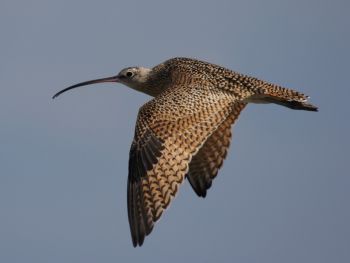- Numenius americanus
Identification
Length 50-65 cm (22½ in), wingspan 85-105 cm (34 in), weight 450-790 g (males), 630-950 g (females)
Distinctive in size, bill length, and color; the largest wader in most of North America. Brown rump and barred tail. Cinnamon wing linings. White eyering, dusky eyeline. Very long, decurved bill. Pale buff head and neck faintly streaked with darker brown. Orange-buff brown underparts with sparse dark streaking on flanks. Dark back with pale edges and notches to feathers. Dark brown outer wing contrasts with paler inner wing in flight. Sexes similar in plumage, though female slightly larger and longer-billed.
Juvenile: Shorter bill, often with less downward curve. Wing coverts with narrow black triangles, not barred ad in adult.
Similar species
Far Eastern Curlew, a rare vagrant in Alaska and British Columbia, differs in being marginally larger, and a more buff-brown color, lacking the orangey tones of Long-billed Curlew. Eurasian Curlew, a rare vagrant in the northeast of North America (where Long-billed is also scarce), differs in buff-brown color, and additionally, conspicuously white on the rump, lower back and underwings in flight. Marbled Godwit shares similar plumage pattern and tones, but is obviously smaller and has a straight bill.
Distribution
Breeds in the west of Canada and the United States, from British Columbia east to Alberta south to northeastern California, Nevada and northern Utah; western Wyoming, most of Montana, western Dakotas, and eastern Colorado and New Mexico; northern Texas. Winters from Oregon and Texas south to southern Mexico and Guatemala. A scarce passage visitor on the Atlantic coast of North America, north to Nova Scotia.
Taxonomy
Variation mostly clinal. Some authorities consider this species to be monotypic3
Subspecies
Two subspecies usually accepted1:
- N. a. americanus - breeds W US in the eastern half of the species' range; winters to Central America.
- N. a. parvus - breeds SW Canada to California; winters to Mexico. Marginally smaller than N. a. americanus.
Habitat
Breeds in grasslands and open prairie. Winters on coasts and lowland grasslands.
Behaviour
Breeding
Nests are located on the ground in open prairie. The female usually lays 4 eggs. Both parents look after the young. Lays April to May, exceptionally late March with replacement nests recorded until early July.
Diet
Diet includes insects, but also eat crustaceans in coastal areas.
Vocalisations
Typical Cur-lee whistle with rising inflection.
References
- Clements, J. F., T. S. Schulenberg, M. J. Iliff, D. Roberson, T. A. Fredericks, B. L. Sullivan, and C. L. Wood. 2018. The eBird/Clements checklist of birds of the world: v2018. Downloaded from http://www.birds.cornell.edu/clementschecklist/download/
- Chandler, R. (2009). Shorebirds of North America, Europe, and Asia: A photographic guide. Princeton Univ. Press.
- Dugger, B. D. and K. M. Dugger (2002). Long-billed Curlew (Numenius americanus), version 2.0. In The Birds of North America (A. F. Poole and F. B. Gill, Editors). Cornell Lab of Ornithology, Ithaca, NY, USA. https://doi.org/10.2173/bna.628
- Van Gils, J., Wiersma, P. & Kirwan, G.M. (2018). Long-billed Curlew (Numenius americanus). In: del Hoyo, J., Elliott, A., Sargatal, J., Christie, D.A. & de Juana, E. (eds.). Handbook of the Birds of the World Alive. Lynx Edicions, Barcelona. (retrieved from https://www.hbw.com/node/53899 on 24 October 2018).
Recommended Citation
- BirdForum Opus contributors. (2025) Long-billed Curlew. In: BirdForum, the forum for wild birds and birding. Retrieved 16 May 2025 from https://www.birdforum.net/opus/Long-billed_Curlew
External Links
GSearch checked for 2020 platform.1







